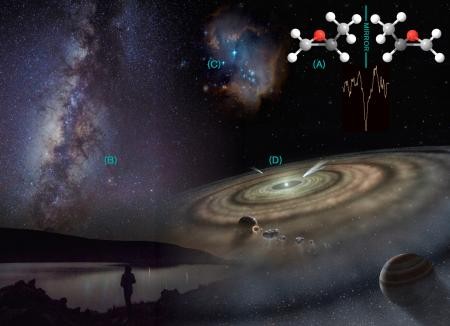Interstellar Organic Molecule to Reveal Why Most Earth Molecules are 'Right Handed'
| Ana Verayo | | Jun 15, 2016 09:27 AM EDT |
(Photo : Graphic, G.A. Blake, Caltech. Galactic center image courtesy B.A. McGuire, young cluster and artist’s rendition of a young protoplanetary system from the NASA Hubble and FUSE/L. Cook archives.) Though chiral compounds have been discovered in meteorites and comets, propylene oxide (A) is the first such molecule to be detected beyond the solar system. A Caltech-led team has used radio telescopes to observe propylene oxide in the cold material surrounding a cluster of protostars near the center of our galaxy, pictured from Mauna Kea (B). Radiation in such young stellar clusters (C) can further process chiral molecules, even as they are incorporated into fledgling planetary systems (D).
Scientists have detected for the first time ever, evidence of an interstellar molecule located some 28,000 light years from Earth. This is also considered the most complex organic molecule to be detected in space.
Like Us on Facebook
This molecule found floating in interstellar space is known as propylene oxide which can also provide better understanding of the early origins of life in the universe, especially the basic building blocks of life.
Scientists from Caltech (California Institute of Technology) also claim that this is also the first most complex molecule found outside the solar system, that can provide new, essential insights about biology.
Apparently, organic molecules also possess a duality even if they appear the same or possess similar properties, that is comparable to humans who are left and right handed. This property is known as "chirality", where scientists are still trying to decipher why most molecules on Earth are more leaning to the left.
This new study is being heralded as a milestone in understanding prebiotic molecules and how they can greatly affect the origins of life. Scientists first detected chiral molecules in comets that are located inside the solar system and even meteorites that reached Earth. These new findings however, reveal their true nature as they are found in interstellar space for the first time.
According to Caltech's Geoffrey Blake, these past few years, the detection of exoplanets revealed that there could even be millions of star systems similar to our solar system, with similar environments as well, where young stars are giving birth to new planets. Upon the detection of propylene oxide, this can lead to clues about interstellar prebiotic chemistry and how this can produce cosmic seeds of life.
More specifically, this propylene oxide was discovered inside a massive star forming dust cloud of gas in the core of the Milky Way with the Green Bank Telescope Prebiotic Interstellar Molecular Survey (PRIMOS) at the National Radio Astronomy Observatory (NRAO).
Molecular structures can biologically form either towards the left or right and from there, they build complex structures from this congruence, where the detection of propylene oxide in space can provide more clues in determining how this molecular handedness emerges in the first place.
For example, biomoleculars like sugar along those DNA molecules lean towards the right, where amino acids that form protein are left handed, as this interstellar molecule can demystify how the ingredients of life in our solar system were formed. To date, there are about 180 molecules detected in space, where they give off distinct vibrations that are detected by radio telescopes.
This new study is published in the journal Science.
Tagsinterstellar molecule, origin of life, organic molecule, propylene oxide, chiral molecules
©2015 Chinatopix All rights reserved. Do not reproduce without permission
EDITOR'S PICKS
-

Did the Trump administration just announce plans for a trade war with ‘hostile’ China and Russia?
-

US Senate passes Taiwan travel bill slammed by China
-

As Yan Sihong’s family grieves, here are other Chinese students who went missing abroad. Some have never been found
-

Beijing blasts Western critics who ‘smear China’ with the term sharp power
-

China Envoy Seeks to Defuse Tensions With U.S. as a Trade War Brews
-

Singapore's Deputy PM Provides Bitcoin Vote of Confidence Amid China's Blanket Bans
-

China warns investors over risks in overseas virtual currency trading
-

Chinese government most trustworthy: survey
-

Kashima Antlers On Course For Back-To-Back Titles
MOST POPULAR
LATEST NEWS
Zhou Yongkang: China's Former Security Chief Sentenced to Life in Prison

China's former Chief of the Ministry of Public Security, Zhou Yongkang, has been given a life sentence after he was found guilty of abusing his office, bribery and deliberately ... Full Article
TRENDING STORY

China Pork Prices Expected to Stabilize As The Supplies Recover

Elephone P9000 Smartphone is now on Sale on Amazon India

There's a Big Chance Cliffhangers Won't Still Be Resolved When Grey's Anatomy Season 13 Returns

Supreme Court Ruled on Samsung vs Apple Dispute for Patent Infringement

Microsoft Surface Pro 5 Rumors and Release Date: What is the Latest?










